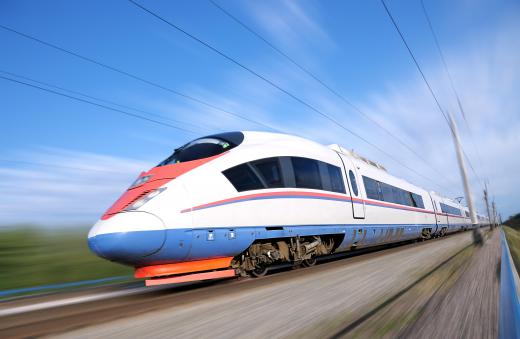What is High-Speed Rail?
 Michael Anissimov
Michael Anissimov
High-speed rail refers to trains that travel on special tracks at over 200 km/h (125 mph). The International Union of railways describes a high-speed train as one that travels faster than 250 km/h (155 mph) on dedicated tracks, or 200 km/h on upgraded conventional tracks. High-speed trains are used most widely in Japan and France, but China and the United States each have one and are considering further adoption. Other countries with high-speed trains include Belgium, Germany, Italy, Portugal, South Korea, Spain, Taiwan, and the United Kingdom. The world's first high-speed train was the Tōkaidō Shinkansen, launched in October 1964, which traveled between Tokyo and Osaka in Japan.
The latest research into high-speed rail involves using maglev tracks, where magnets are carefully arranged to allow the train to actually float above the tracks. This is relatively expensive, but greatly lowers friction and increases possible top speed. The Japanese maglev train, JR-Maglev MLX01, reached 361 mph (580.9 kph) in 2003, setting the record for fastest train. The record for conventional rail trains was set by the French TGV, train a grande vitesse, which reached 357.2 mph (574.8 kph) on 3 April 2007.

High-speed trains are an effective form of transportation in areas where population density is high and distances are long but not too long. This explains their adoption in France and Japan. The longer preparation times associated with going to the airport, getting past security, boarding, taxiing and takeoff, make high-speed trains an appealing alternative to air travel under certain circumstances. Proposals have been put forth for high-speed train development between Boston, New York, and Washington, D.C., on the East Coast and between San Francisco and Sacramento in California.

Some advantages of high-speed trains over air travel are greater capacity, less fuel expenditure, lower cost, less pollution, and better security. As a rule of thumb, it is considered that high-speed trains beat aircraft on convenience for trips under 3 hours. For a high-speed train traveling at 300 kph (186 mph) or 400 kph (249 mph), this can extend to significant distances. The capital cost of investing in a new high-speed rail system and building the dedicated tracks makes investors wary of such proposals, an issue also seen in nuclear power.
AS FEATURED ON:
AS FEATURED ON:
















Discuss this Article
Post your comments